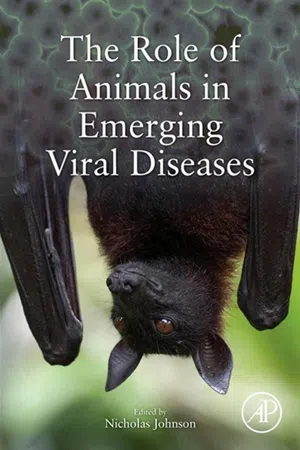
- 364 pages
- English
- ePUB (mobile friendly)
- Available on iOS & Android
The Role of Animals in Emerging Viral Diseases
About This Book
The Role of Animals in Emerging Viral Diseases presents what is currently known about the role of animals in the emergence or re-emergence of viruses including HIV-AIDS, SARS, Ebola, avian flu, swine flu, and rabies. It presents the structure, genome, and methods of transmission that influence emergence and considers non-viral factors that favor emergence, such as animal domestication, human demography, population growth, human behavior, and land-use changes.
When viruses jump species, the result can be catastrophic, causing disease and death in humans and animals. These zoonotic outbreaks reflect several factors, including increased mobility of human populations, changes in demography and environmental changes due to globalization. The threat of new, emerging viruses and the fact that there are no vaccines for the most common zoonotic viruses drive research in the biology and ecology of zoonotic transmission.
In this book, specialists in 11 emerging zoonotic viruses present detailed information on each virus's structure, molecular biology, current geographic distribution, and method of transmission. The book discusses the impact of virus emergence by considering the ratio of mortality, morbidity, and asymptomatic infection and assesses methods for predicting, monitoring, mitigating, and controlling viral disease emergence.
- Analyzes the structure, molecular biology, current geographic distribution and methods of transmission of 10 viruses
- Provides a clear perspective on how events in wildlife, livestock, and even companion animals have contributed to virus outbreaks and epidemics
- Exemplifies the "one world, one health, one medicine" approach to emerging disease by examining events in animal populations as precursors to what could affect humans
Frequently asked questions
Information
Table of contents
- Cover image
- Title page
- Table of Contents
- Copyright
- Dedication
- Contributors
- Foreword
- Chapter 1. A Short Introduction to Disease Emergence
- Chapter 2. Patterns of Foot-and-Mouth Disease Virus Distribution in Africa: The Role of Livestock and Wildlife in Virus Emergence
- Chapter 3. Parvoviruses of Carnivores: Their Transmission and the Variation of Viral Host Range
- Chapter 4. Rabies: Animal Reservoirs of an Ancient Disease
- Chapter 5. Lassa Fever: A rodent-human interaction
- Chapter 6. Henipaviruses: Deadly Zoonotic Paramyxoviruses of Bat Origin
- Chapter 7. The Role of Birds in the Spread of West Nile Virus
- Chapter 8. Rift Valley Fever Virus: A Virus with Potential for Global Emergence
- Chapter 9. From Simian to Human Immunodeficiency Viruses (SIV to HIV): Emergence from Nonhuman Primates and Transmission to Humans
- Chapter 10. Hantavirus Emergence in Rodents, Insectivores and Bats: What Comes Next?
- Chapter 11. Nipah Virus: A Virus with Multiple Pathways of Emergence
- Chapter 12. Synthesis
- Index